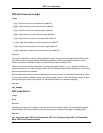
ISPF Shift Lines Left or Right
Usage
• ( [n] - Shift the current line n columns left, default 2
• (( [n] - Shift the block of lines n columns left, default 2
• ) [n] - Shift the current line n columns right, default 2
• )) [n] - Shift the block of lines n columns right, default 2
• < [n] - Data shift the current line n columns left, default 2
• << [n] - Data shift the block of lines n columns left, default 2
• > [n] - Data shift the current line n columns right, default 2
• >> [n] - Data shift the block of lines n columns right, default 2
Remarks
This set of commands is used for shifting data left or right. The versions using parenthesis shift text liter-
ally, while the other versions attempt to intelligently shift text without disturbing line numbers or com-
ments. In all cases, the default number of columns that the text is shifted is two.
There are two forms to these commands. The single character forms (, ), <, or > specifies that the line
and the subsequent n-1 lines are to be shifted. The two-character block forms are placed on the first and
last lines of the block to be shifted.
Data is shifted only within the columns defined by the current bounds, or if bounds is turned off, but there
is a truncation column, between column 1 and the truncation column. If the shift operation results in data
moving beyond the right or left margins, it is truncated and there is no warning message.
See Also
ispf_bounds
ISPF Insert After A
Usage
A [n]
Remarks
Identifies a line after which copied or moved lines are to be inserted n times. You are allowed to specify
multiple A, B, or O line commands to have the same copy or move block inserted in multiple places.
See Also
ispf_copy, ispf_paste, ISPF Line Command B, ISPF Line Command Copy, ISPF Line Command
Move, ISPF Line Command Overlay
ISPF Line Commands
508


















